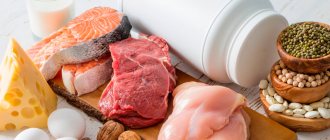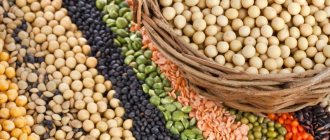What are essential amino acids?
Amino acids are organic compounds consisting of nitrogen, carbon, hydrogen and oxygen.
Your body needs 20 different amino acids to grow and function properly. Although all 20 of them are important for your health, only nine amino acids are classified as essential ().
These nine essential amino acids are: histidine, isoleucine, leucine, lysine, methionine, phenylalanine, threonine, tryptophan and valine.
Unlike nonessential amino acids, essential amino acids cannot be synthesized by your body and must be obtained from your diet. The best sources of essential amino acids are animal proteins such as meat, eggs and poultry.
When you eat protein, it is broken down into amino acids, which are then used to help your body with various processes such as building muscle and regulating immune function ().
Proteinogenic amino acids
For the synthesis of almost any protein, only 20 amino acids are needed: leucine (L), isoleucine (I), valine (V), lysine (K), methionine (M), threonine (T), tryptophan (W), phenylalanine (F) , histidine (H), arginine (R), cysteine (C), tyrosine (Y), glycine (G), proline (P), glutamine (Q), glutamic acid (E), alanine (A), asparagine (N ), aspartic acid (D), serine (S).
The entire huge variety of proteins is made up of these 20 amino acids. The number of variants of a chain of several dozen amino acids is truly immense.
Conditionally essential amino acids
There are several non-essential amino acids that are classified as conditionally essential. They are only considered important under certain circumstances, such as illness or stress.
For example, although arginine is considered a nonessential amino acid, your body cannot meet the requirement for this amino acid while fighting diseases such as cancer ().
This is why arginine must also be supplied through food to meet your body's needs in certain situations.
Conclusion:
The nine essential amino acids cannot be synthesized by your body and must be obtained from food. Conditionally essential amino acids are only needed under special circumstances, such as illness.
Let's move on to practice
For clarity, you can consider this example. Let’s assume that the body’s need for protein is 120 g.
Based on the above ratios, it is concluded that the required amount of amino acids is:
The daily requirement of amino acids depends on several factors, for example, the health status and age of a particular person.
- leucine – 8.4 g;
- isoleucine – 4.8 g;
- valine – 6 g.
The largest amount of protein compounds can be obtained from meat products, especially chicken breast, due to its low fat content. Other sources of animal proteins include milk and eggs. It is worth distributing the foods to be taken throughout the day: in the morning - eggs, lunch - meat, dinner - milk.
With the average statistical distribution of proteins contained in products, it is possible to obtain amino acids:
- 2.8 g leucine;
- 1.6 g isoleucine;
- 2 g valine.
To identify food products, you need to study information about the composition of products in the form of amino acids. This data is freely available on the Internet.
The final step is to calculate the amount of products required to cover the body's daily needs. The calculation is easily carried out using a calculator, since the actions are elementary.
The role of essential amino acids in the body
The nine essential amino acids perform a number of important and diverse functions in your body:
- Phenylalanine : Phenylalanine is a precursor to the neurotransmitters tyrosine, dopamine, epinephrine and norepinephrine. It plays an important role in the structure and function of proteins and enzymes, and in the production of other amino acids ().
- Valine : Valine is one of three branched chain amino acids. This means that one chain has a branch in one direction from its molecular structure. Valine helps stimulate muscle growth and regeneration and is involved in energy production ().
- Threonine : Threonine is a major part of structural proteins such as collagen and elastin, which are important components of skin and connective tissue. It also plays a role in fat metabolism and immune function ().
- Tryptophan : Although tryptophan is often associated with sleepiness, it has many other functions. It is essential for maintaining proper nitrogen balance and is a precursor to serotonin, a neurotransmitter that regulates your appetite, sleep and mood ().
- Methionine : Methionine plays an important role in metabolism and detoxification. It is also essential for tissue growth and the absorption of zinc and selenium, minerals that are vital to your health ().
- Leucine : Like valine, leucine is a branched-chain amino acid that is critical for protein synthesis and muscle repair. It also helps regulate blood sugar, stimulates wound healing, and produces growth hormones ().
- Isoleucine : The last of the three branched chain amino acids. Isoleucine is involved in muscle metabolism and is highly concentrated in muscle tissue. It is also important for immune function, hemoglobin production and energy regulation ().
- Lysine : Lysine plays an important role in protein synthesis, hormone and enzyme production, and calcium absorption. It is also important for energy production, immune function, and the production of collagen and elastin ().
- Histidine : Histidine is used to produce histamine, a neurotransmitter that is vital for immune response, digestion, sexual function and sleep-wake cycles. It is important for maintaining the myelin sheath, the protective barrier that surrounds your nerve cells ().
As you can see, essential amino acids underlie many vital processes.
Although amino acids are most recognized for their role in muscle development and recovery, the body depends on them for much more. This is why a deficiency of essential amino acids negatively affects the entire body, including the nervous, reproductive, immune and digestive systems.
Conclusion:
All nine essential amino acids serve a variety of roles in your body. They are involved in important processes such as tissue growth, energy production, immune function and nutrient absorption.
Amino acids
Valin (Val, V)
A little history
Most amino acids were discovered during the second half of the twentieth century during the search for new antibiotics from fungi, seeds, fruits and animal fluids. The first amino acid, asparagine, was discovered in 1806. It was isolated from asparagus juice by the French chemist Louis-Nicolas Vauquelin and assistant Pierre Jean Robiquet. A little later, leucine was obtained from cheese and cottage cheese.
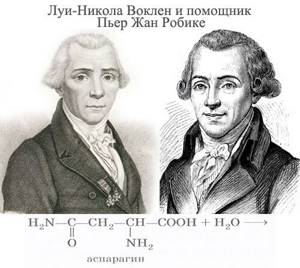
What are amino acids
From a biochemical point of view, amino acids are organic substances consisting of a carbon skeleton, an amine and a carboxyl group. Thanks to the last two radicals, amino acids have the unique ability to exhibit the properties of both acids and alkalis.
Proteins make up 20% of the human body; they take part in all biochemical processes, and amino acids are the “building material” for them. The cells and tissues of the human body are composed primarily of amino acids, the key role of which is the transport and storage of nutrients.
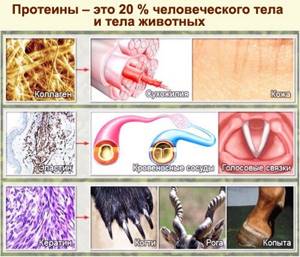
Amino acids are vital for the body; without them, the synthesis of hormones, pigments, vitamins and purines is impossible. Not all amino acids can be synthesized by the human body, unlike some microorganisms and plants; they must be obtained from food.
Today, there are about 500 amino acids known to occur in nature. But only 20 of them are so-called standard proteinogenic amino acids. They, in fact, make up a polypeptide chain containing the genetic code.
Table. Standard Proteinogenic Amino Acids
| Amino acid | Abbreviation | Source |
| Glycine | Gly,G | Gelatin |
| Leucine | Leu, L | Muscle fibers |
| Tyrosine | Tyr, Y | Casein |
| Serin | Ser, S | Silk |
| Glutamic acid | Glu, E | Plant proteins |
| Glutamine | Gln, Q | |
| Aspartic acid | Asp,D | Conglutin, legumin (asparagus sprouts) |
| Asparagine | Asn, N | Asparagus juice |
| Phenylalanine | Phe, F | Lupine sprouts |
| Alanin | Ala, A | Silk fibroin |
| Lysine | Lys, K | Casein |
| Arginine | Arg, R | Horn substance |
| Histidine | His, H | Sturin, histones |
| Cysteine | Cys,C | Horn substance |
| Valin | Val, V | Casein |
| Proline | Pro, P | Casein |
| Hydroxyproline | Hyp, hP | Gelatin |
| Tryptophan | Trp,W | Casein |
| Isoleucine | Ile, I | Fibrin |
| Methionine | Met, M | Casein |
| Threonine | Thr, T | Oat proteins |
| Hydroxylysine | Hyl, h.K. | Fish proteins |
There are several ways to classify amino acids, the most popular is classification according to the method of synthesis. According to it, amino acids are divided into two types:
- Essential amino acids are amino acids that are not synthesized in the human body;
- Replaceable - those that the human body is capable of reproducing on its own.
Replaceable and essential amino acids
The following amino acids are essential but essential for the human body: alanine, asparagine, aspartate, glycine, glutamine, glutamate, proline, serine, tyrosine, cysteine, hydroxyproline, hydroxylysine.
Essential amino acids are those that cannot be synthesized independently in the human body and include: valine, isoleucine, leucine, lysine, methionine, threonine, tryptophan and phenylalanine, histidine, arginine. Arginine is also not synthesized in the child’s body, which is why it is also considered essential.

What foods contain amino acids
Amino acids are components of protein and, accordingly, it would be logical to assume that they are contained specifically in protein products, and this is true. Large amounts of amino acids are found in eggs, dairy products, meat and fish. From products of plant origin you can also obtain amino acids essential for the body. Their content is high in soybeans, lentils, beans and other legumes. Nuts and seeds contain high amounts of histidine, arginine and lysine, and grains contain leucine, valine and isoleucine.
Below is a table that shows which foods you can get essential amino acids from and their role in the body.
Table. Foods containing essential amino acids
| Name | What products contain | Role in the body |
| Leucine | Nuts, oats, fish, eggs, chicken, lentils | Reduces blood sugar |
| Isoleucine | Chickpeas, lentils, cashews, meat, soy, fish, eggs, liver, almonds, meat | Restores muscle tissue |
| Lysine | Amaranth, wheat, fish, meat, most dairy products | Takes part in calcium absorption |
| Valin | Peanuts, mushrooms, meat, legumes, dairy products, many grains | Takes part in nitrogen metabolic processes |
| Phenylalanine | Beef, nuts, cottage cheese, milk, fish, eggs, various legumes | Memory improvement |
| Threonine | Eggs, nuts, beans, dairy products | Synthesizes collagen |
| Methionine | Beans, soybeans, eggs, meat, fish, legumes, lentils | Takes part in radiation protection |
| Tryptophan | Sesame, oats, legumes, peanuts, pine nuts, most dairy products, chicken, turkey, meat, fish, dried dates | Improves and deepens sleep |
| Histidine (partially replaceable) | Lentils, soybeans, peanuts, tuna, salmon, beef and chicken, pork tenderloin | Takes part in anti-inflammatory reactions |
| Arginine (partially replaceable) | Yogurt, sesame, pumpkin seeds, Swiss cheese, beef, pork, peanuts | Promotes growth and repair of body tissues |
You can find out more about each amino acid by going to its page.
Our body needs amino acids every day and, according to biological research, the daily protein intake is from 0.5 to 2 grams per day per 1 kilogram of weight. Protein from different foods is absorbed by the body differently. It is believed that protein obtained from eggs, cottage cheese and fish is best absorbed.
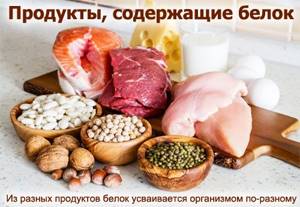
Amino acids in the human body
The human body consists of 20% protein - it is the main building material for muscle tissue, all organs and cells. Protein is our skin and hair, blood cells, muscles and all other systems.
Amino acids, in turn, are the building blocks of protein. Essentially, we can say that protein (protein) is made up of amino acids.
In the human body, amino acids perform essential functions: they take part in the synthesis of hormones, pigments and vitamins, and play a key role in the transport and storage of nutrients.

Here is a list of just a few of the most important functions of amino acids in the body:
- First of all, amino acids are needed for the formation of protein, which is part of the muscle tissue of ligaments and tendons.
- Amino acids optimize recovery processes and accelerate the healing of skin damage.
- Amino acids are very important for the normal functioning of the brain and nervous system.
- Amino acids also play an important role in the formation of enzymes.
- Without amino acids, normal quality sleep is impossible.
- And finally, amino acids affect the health of hair, nails and skin.
From all of the above points, it is clear that amino acids are necessary for humans and they need to be received in abundance for the normal functioning of all body systems. Below we will look at what happens when there is a lack of amino acids, their excess, and from what foods you can get essential amino acids.

Deficiency and excess of amino acids
Our body is designed in such a way that everything should be in harmony and balance. Therefore, negative consequences occur both with a lack of amino acids and with their excess. Each amino acid performs its own function in the body, it has its own tasks, and accordingly, it often happens that the body lacks not all amino acids, but only a few; to identify the deficiency, there is a special blood test. You will also need to take a blood test to check for vitamin deficiencies, because amino acids are soluble and in our body they interact with vitamins B, , and.

When there is a lack of amino acids, a person experiences the following symptoms:
- Weakness, drowsiness.
- Decreased appetite or complete loss of it.
- Hair loss, deterioration of skin condition.
- Delayed growth and development in children.
- Anemia.
- Decreased immunity, and as a result, low resistance to viruses and infections.
- An excess of amino acids, as well as a lack of them, leads to disruptions in the functioning of various body systems. As a rule, negative consequences from an excess of amino acids are possible only with a deficiency of selenium and a lack of vitamins A, E, C, B.
With an excess of amino acids in the body, the following problems may arise: dysfunction of the thyroid gland, hypertension (excess tyrosine), joint problems (excess histidine), early gray hair (excess histidine), and an increased risk of heart attacks and strokes (excess methionine).
Table. The use of amino acids and their dosage
| Amino acid | Application | Dosage (as a dietary supplement for athletes) | Overdose; Shortage |
| Histidine | Treats arthritis, nerve deafness, improves digestion, necessary for babies and children during growth | 8-10 mg per 1 kg of weight (minimum 1 g per day) | Mental disorders, anxiety, schizophrenia, stress; Unknown. |
| Lysine | Treats herpes, adds energy, promotes muscle protein production, fights fatigue, maintains nitrogen balance in the body, important for calcium absorption and retention, promotes collagen formation | 12 mg per 1 kg of weight | Increased cholesterol, diarrhea, gallstones; Impaired enzyme production, weight loss, decreased appetite, decreased concentration. |
| Phenylalanine | Treats depression, arthritis, nervous disorders, seizures, relieves muscle tension, important for the production of neurotransmitters serotonin and melatonin | 1 mg per 1 kg of weight | High blood pressure, migraines, nausea, disruption of the heart and nervous system. Not recommended for pregnant women and diabetics; Lethargy, weakness, growth retardation, liver dysfunction. |
| Methionine | Treatment of liver, arthritis, depression, accelerates fat metabolism and improves digestion, antioxidant, prevents the accumulation of excess fat in blood vessels and liver, removes toxins | 12 mg per 1 kg of weight | Possible with deficiency of B vitamins. Atherosclerosis; Fatty liver degeneration, growth retardation, lethargy, swelling, skin diseases. |
| Leucine | Prevents muscle wasting, natural anabolic agent, promotes wound healing and is important for growth hormone production | 16 mg per 1 kg of weight | Increases ammonia levels; Unknown. |
| Isoleucine | Heals wounds, releases growth hormone, regulates blood sugar, is important for the formation of hemoglobin, is responsible for muscle structure | 10-12 mg per 1 kg of weight | Causes frequent urination, use with caution if you have kidney or liver disease; Unknown. |
| Valin | Regulates nitrogen balance, restores and promotes muscle growth | 16 mg per 1 kg of weight | Skin tingling, hallucinations, prohibited for people with liver or kidney disease; Maple syrup disease. |
| Threonine | Important for the production of collagen, elastin, antibodies, maintains muscle health, stimulates growth, and is used to treat mental health | 8 mg per 1 kg of weight | Unknown; Irritability, weakened immunity. |
| Tryptophan | Important for the production of serotonin and melatonin, necessary during growth | 3.5 mg per 1 kg of weight | Dizziness, migraines, vomiting, diarrhea; May cause the development of tuberculosis, cancer, diabetes, and dementia. |
| Arginine | Responsible for muscle recovery, rapid healing of wounds and injuries, removes toxins, strengthens the immune system | 0.4 mg per 1 kg of weight | Diseases of the pancreas, liver; Decreased blood pressure, weakness, indigestion. |
People with genetic disorders in the process of assimilation of amino acids, vegetarians, bodybuilders and people who simply do not watch their diet are at risk.
Amino acids in sports nutrition
Additional amino acid supplementation has recently become very popular among athletes, especially bodybuilders. Without a sufficient amount of amino acids, muscle mass growth is impossible. The thing is that building muscle mass is a systematic process of microdamage to muscle fibers and their healing. And just for the healing of muscle fibers, protein is needed as a building material. In order to consume a sufficient amount of protein, an athlete needs to carefully think through his diet; in the modern pace of life, this is not always possible, and this is where protein and amino acid complexes (BCAAs) come to the rescue.
BCAA (from the English. Branched-chain amino acids) is a complex consisting of three essential amino acids:
- Leucine
- Isoleucine
- Valine
Leucine, isoleucine and valine make up 35% of all amino acids in muscle tissue and take part in the processes of anabolism and muscle recovery, and also have an anti-catabolic effect. BCAAs are essential amino acids and cannot be synthesized independently, so a person is forced to obtain them with food or special supplements in the form of capsules or powder. Once in the body, BCAAs are primarily metabolized in the muscles, and are a kind of “fuel” for the growth of muscle mass. This is how they differ from the other 17 amino acids. This property helps to significantly improve athletic performance and improves the athlete’s well-being after a long workout. BCAAs are safe for health if the dosage is not exceeded.

It should be noted that protein and amino acid complexes should be taken according to the instructions on the package, without exceeding the daily allowance.
To summarize, we can say with confidence that amino acids are what our body needs every day to maintain the normal functioning of all body systems. You can get them not only from animal products, but also from cereals, legumes and nuts. If a person eats well, does not engage in bodybuilding and does not have any genetic abnormalities, then he does not need additional intake of amino acids in powders and capsules.
Benefits of Taking Essential Amino Acid Supplements
While essential amino acids can be found in a wide range of foods, taking concentrated doses in supplement form is associated with several health benefits.
May help improve mood and sleep
Tryptophan is essential for the production of serotonin, a chemical that acts as a neurotransmitter in your body.
Serotonin is an important regulator of mood, sleep and behavior.
While low serotonin levels are associated with depressed mood and sleep disturbances, several studies have found that taking tryptophan supplements may reduce symptoms of depression, boost mood, and improve sleep (, , , , ).
A 19-day study of 60 older women found that 1 gram of tryptophan per day resulted in increased energy levels and improved happiness compared to placebo ().
Can improve performance in sports
The three essential branched chain amino acids are widely used to relieve fatigue, improve athletic performance, and promote muscle recovery after exercise.
In a study of 16 weightlifters, branched chain amino acids were found to improve muscle performance and recovery, and reduce muscle soreness compared to a placebo ().
A recent review of eight studies found that taking branched-chain amino acid supplements stimulated muscle recovery and reduced soreness after exhaustive exercise ().
Additionally, 4 grams of leucine per day for 12 weeks increased strength in untrained men, showing that essential amino acids may also benefit non-strength athletes ().
May prevent muscle loss
Loss of muscle mass is a common side effect of long-term illness and bed rest, especially in older adults.
Essential amino acids have been found to prevent muscle breakdown and maintain lean body mass.
A 10-day study of 22 older adults on bed rest found that those who received 15 grams of an essential amino acid mixture maintained muscle protein synthesis, while those receiving a placebo decreased muscle protein synthesis by 30% ().
Essential amino acid supplements have been found to be effective in maintaining lean body mass in older adults and athletes (, ).
May promote weight loss
Some human and animal studies have shown that branched chain essential amino acids may be effective in promoting the loss of body fat mass.
For example, an eight-week study of 36 strength-training men found that taking 14 grams of branched-chain amino acids per day significantly reduced body fat percentage compared to taking whey protein or sports drinks ().
A study in rats found that a diet supplemented with 4% leucine reduced body and fat mass ().
However, other studies examining the potential link between branched chain amino acids and weight loss have been inconsistent. More research is needed to determine whether these amino acids can promote weight loss (, ).
Conclusion:
Taking supplements of certain essential amino acids can help improve your mood, enhance exercise performance, prevent muscle loss, and promote weight loss.
When, where and how much?
Content
The amount of amino acids needed by humans varies greatly. Depending on their type, replaceable and irreplaceable substances are distinguished. The second category is the most necessary elements, since they can enter the body exclusively from the outside along with food or supplements. If their quantity is not enough, the body will face negative consequences. In terms of training, there will be stagnation or even a loss of strength with a decrease in muscle mass.
The amount of amino acids per day depends on the type of substance:
- valine is one of the key sources of energy processing for muscles. This amino acid is involved in maintaining nitrogen balance and is necessary for the production of pantothenic acid. Valine can be obtained from meat and dairy dishes, as well as soy and grain crops. The daily dose is 2.5 g. With a deficiency of substances, there is a disorder of the coordination center and central nervous system function;

By providing the diet with a full range of nutrients, you can guarantee stable muscle growth, a strong immune system, and rapid recovery
- isoleucine. The daily requirement for amino acids of this type is 2 g/day. Isoleucine is indispensable for muscle development; it ensures an increase in protein in muscle fibers. There is a lot of it in cheese, meat products, fish and apples;
- leucine is an essential participant in the synthesis of various steroids. To obtain amino acids from the outside, you need to consume legumes, hazel and meat. The daily norm of amino acids of this type is 4.6 g. In the event of a deficiency, pathology of the thyroid gland may occur, and for athletes, loss of muscle mass is especially undesirable;
- Lysine is found in large quantities in milk and milk products, apples and meat. Its main function is to ensure high-quality hormone production. Other important effects include accelerating muscle recovery and stimulating mass gain. Calculate how many amino acids you need per day based on a dose of 4.1 g minus the amount from food. If the dosage is insufficient, circulatory pathology may occur, the amount of hemoglobin synthesis decreases and muscle growth is inhibited;
- methionine is important for the production of adrenaline, choline and a number of essential substances. How many amino acids a particular person will need depends on his weight and body structure, on average the figure is within 1.8 g. Methionine acts as a participant in the metabolism of phospholipids, vitamin elements and complex fats. If daily consumption is insufficient, it significantly reduces the quality and intensity of muscle tissue development. Deficiency can be expressed in impaired protein secretion and other functional failures. To cover the deficit you need to eat fish, cottage cheese, vegetables and fruits;
- tyrosine The daily dose is 4.4 g. To replenish reserves, you should eat almonds, seeds and milk. The main task is to normalize the biological synthesis of melanin, dopamine and adrenaline. If the daily requirement of essential amino acids, especially tyrosine, is not met, dementia may develop;

Of all the amino acids, the most important for the body are essential
- Threonine is an important participant in the replenishment of cells with protein compounds. Thanks to its influence, muscles grow much faster, and the skin becomes more youthful, the reason being the release of elastin and collagen. Threonine stimulates muscle development and strengthens immune function. The amino acid can be obtained from salmon, milk, fruits, vegetables and meat. The normal amount is 2.4 g;
- tryptophan will be supplied in sufficient quantities when eating cheeses, rice and meat. After taking the amino acid, muscle growth processes are launched and tissue restoration is accelerated. Under the influence of tryptophan, serotonin is abundantly released. In acute forms of deficiency, diabetes, tuberculosis, oncology, etc. may develop. The body's daily needs are small, only 0.8 g/day, but the deficiency is acutely tolerated;
- Phenylalanine is present in beef, milk and milk products. The amino acid affects the production of adrenaline, enhances thyroid function and normalizes the functioning of the central nervous system. If taken in small quantities, a person may develop mental retardation. Normally, the intake should be 4.4 g/day;
- Cystine is considered one of the most important amino acids; they must be consumed in a timely manner and in sufficient quantities. You can get cystine from red peppers, cheese, onions, garlic, fish, meat and milk. The amino acid participates in the binding of arsenic, stimulates the high-quality release of energy, and maintains the normal structure of the protein. Cystine is one of the main amino acids that affects protein synthesis.
Food Sources and Recommended Daily Intake
Since your body cannot produce essential amino acids, they must come from your diet.
Luckily, many foods are rich in essential amino acids, making it easy to meet your daily needs.
Here is the recommended daily intake of nine essential amino acids per 1 kg of body weight ():
- Histidine: 14 mg.
- Isoleucine: 19 mg.
- Leucine: 42 mg.
- Lysine: 38 mg.
- Methionine (+ essential amino acid cysteine): 19 mg.
- Phenylalanine (+ essential amino acid tyrosine): 33 mg.
- Threonine: 20 mg.
- Tryptophan: 5 mg.
- Valine: 24 mg.
Foods containing all nine essential amino acids are called complete proteins.
Sources of complete protein include:
- Meat
- Seafood
- Domestic bird
- Eggs
- Dairy
Soy, quinoa and buckwheat are plant foods that contain all nine essential amino acids, making them also sources of complete protein ().
Other plant sources of protein, such as legumes and nuts, are considered incomplete because they lack one or more essential amino acids.
However, if you follow a plant-based diet (vegetarian, vegan), you can still ensure adequate intake of all essential amino acids if you eat a range of plant proteins every day.
For example, eating plenty of whole proteins such as legumes, nuts, seeds, whole grains and vegetables can ensure that your essential amino acid needs are met even if you decide to eliminate animal products from your diet.
Conclusion:
Both animal and plant foods such as meat, eggs, buckwheat and soy can contain all nine essential amino acids and are considered complete proteins.
How to determine the daily requirement for amino acids?
To determine how many amino acids the human body needs, you need to know 2 main indicators:

If they are deficient, serious health problems may occur.
- the most important factor is the required amount of protein for the body;
- the proportion of amino acids in each gram of protein.
After multiplying the proportion of amino acid by the required amount of protein, you can determine the daily requirement for each substance. To create 1 g of protein, a fixed amount of amino acids is not used, but to establish the ideal structure, science has introduced a formula for the ideal composition of the protein. You can find out the number of amino acids in 1 g from the table.
| Amino acid | Amount of mg per 1 g of protein |
| leucine | 70 |
| tyrosine and methionine | 60 |
| lysine | 55 |
| valine | 50 |
| isoleucine and threonine | 40 |
| cysteine and methionine | 35 |
| tryptophan | 10 |
Taking into account the information from the table, you can calculate the correct individual dose of the amino acid for any athlete. Minor fluctuations are acceptable, since achieving the ideal composition is extremely difficult.
Summarize
- There are nine essential amino acids that you should include in your diet: histidine, isoleucine, leucine, lysine, methionine, phenylalanine, threonine, tryptophan and valine.
- They are vital for functions such as protein synthesis, tissue repair and nutrient absorption.
- Some may also prevent muscle loss and improve mood, sleep, athletic performance, and aid weight loss.
- Luckily, these vital compounds are found in many animal and plant foods that can help you meet your daily needs through a healthy, balanced diet.
Proteins and amino acids
Proteins are absolutely necessary substances for the existence of the body. They participate in metabolic processes, they make up hormones and antibodies, blood cells and muscle fibers. However, a piece of well-fried beef by itself will never become the building material for bodybuilder Kolya’s biceps. First, the meat must be digested - that is, with the help of digestive enzymes, the protein contained in the meat must be broken down into its constituent amino acids, and then new proteins must be assembled from these “building blocks” - already in the coli muscle.
Transanimation
Transanimation is the reaction of transferring an amino group from an amino acid to a keto acid without the formation of ammonia. The transfer is carried out due to the action of transaminase - enzymes from the group of transferases.
Most of these reactions involve the transfer of amino groups to alpha-ketoglutarate, forming new alpha-ketoglutaric acid and glutamate. An important transaminase reaction is branched-chain amino acids (BCAAs), which are absorbed directly into the muscles.
In this case, the BCAAs are removed and transferred to alpha-ketoglutarate, forming branched-chain keto acids and glutamic acid.
Typically, transanimation involves amino acids that are most abundant in tissues - alanine, glutamate, aspartate.



